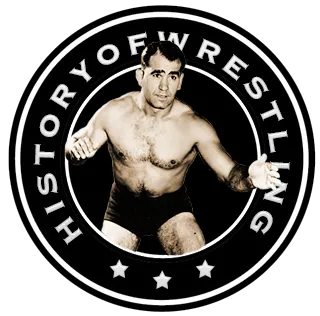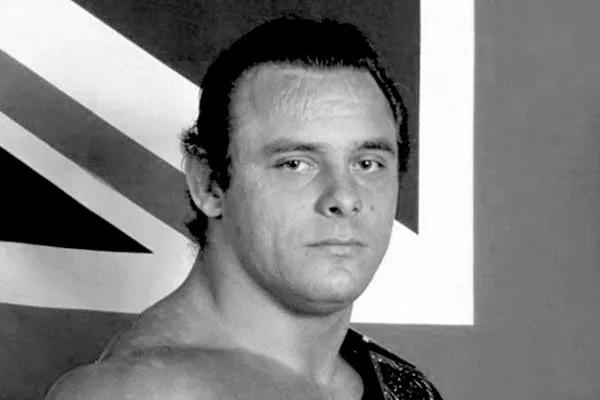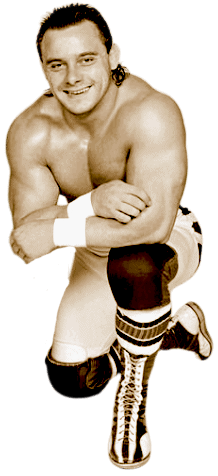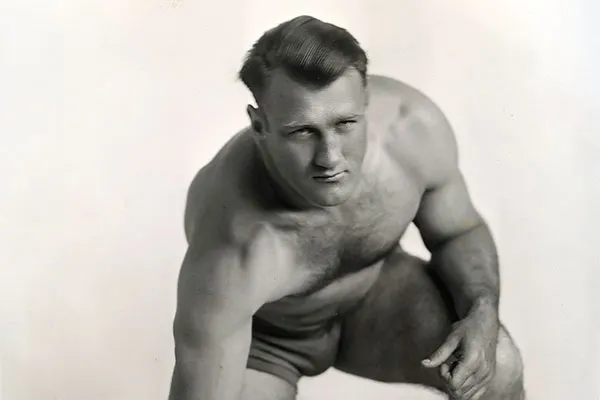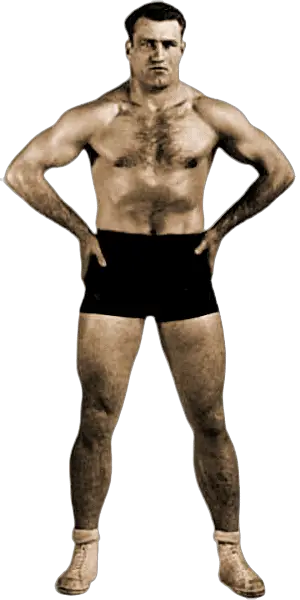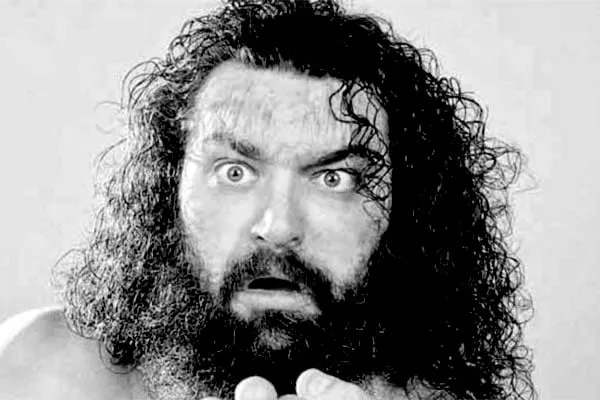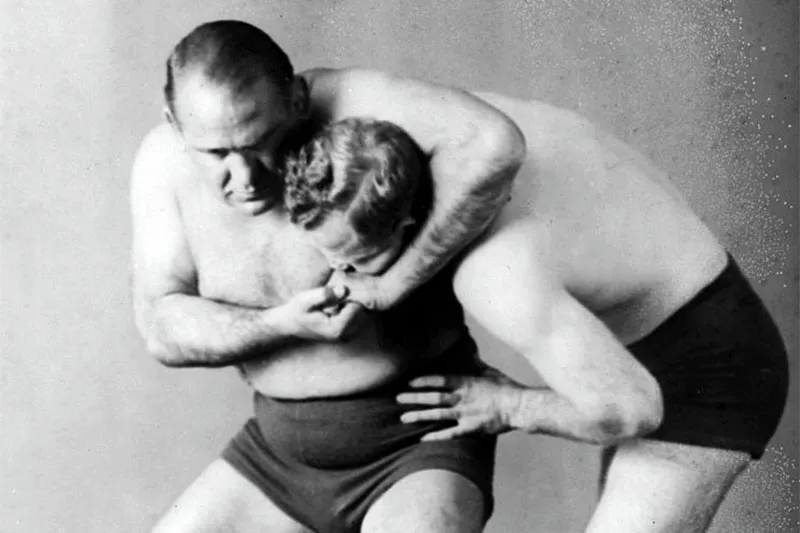ssa
by Stephen Von Slagle
Tom Billington, known across the globe as The Dynamite Kid, was a world-traveler who wrestled frequently on his home continent of Europe, as well competing extensively in Canada, the U.S. and Japan. His talent was known far and wide, even before he gained mainstream fame along with cousin Davey Boy Smith as part of The British Bulldogs during the WWF’s explosion of popularity in the mid-1980s. In the ten years he wrestled prior to entering the World Wrestling Federation, Tom Billington clearly established himself as one of, if not the top, Junior Heavyweight in the world. His style, and execution of particular moves (such as the Snap-Suplex and Flying Headbutt) has been an inspiration for numerous wrestlers, including many heavyweights. The supremely conditioned Dynamite Kid’s technique of incorporating impressive, high-flying moves with a truly dangerous and equally exciting mat attack also had a huge influence on his Japanese audience, which included many future Cruiserweight and Heavyweight superstars. Be it North America, Europe or Japan, The Dynamite Kid helped keep the Junior Heavyweight-Light Heavyweight-Cruiserweight division alive during a very trying time for the lighter weight class. Without The Kid’s incredible talent and ability to draw interest and live audiences, the high-flyers of today would not have such a comfortable place in the current wrestling product.
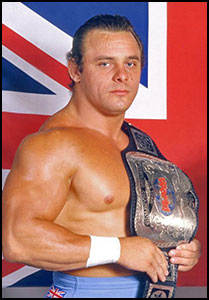 Tom Billington was born on December 5, 1958 in Golborne, England. After meeting former wrestler Ted Betley, who encouraged him to give the sport a try, he began his training under Betley at the age of just 13 years old. Seeing his natural talent, Betley brought the young Billington to Riley’s Gym in Wigan, a place well-known as the toughest shooter training ground in England. After being brutalized at “The Snake Pit” and, eventually, learning how to reciprocate that punishment, in 1975 the teenager began his career as a professional wrestler in the gritty, underground world of the British independent scene. Despite his small stature, (during this time period, the 5’8″ Billington weighed considerably less than 200 lbs.) he quickly earned a reputation throughout the country as being a legitimate future star. The Dynamite Kid’s explosive timing and high-impact repertoire lived up to his ring moniker, resulting in championship after championship once he joined the Crabtree brothers’ Joint Promotions. He was initially paired with the promotion’s top star, “Big Daddy” Shirley Crabtree, and the two combined for an entertaining “David and Goliath” team. A hit with the fans, at the age of 18 he became the youngest British Lightweight champion in history when he defeated Jimmy Breaks in 1977 and then, in 1978, he toppled Bobby Ryan to become the British Welterweight champion.
Tom Billington was born on December 5, 1958 in Golborne, England. After meeting former wrestler Ted Betley, who encouraged him to give the sport a try, he began his training under Betley at the age of just 13 years old. Seeing his natural talent, Betley brought the young Billington to Riley’s Gym in Wigan, a place well-known as the toughest shooter training ground in England. After being brutalized at “The Snake Pit” and, eventually, learning how to reciprocate that punishment, in 1975 the teenager began his career as a professional wrestler in the gritty, underground world of the British independent scene. Despite his small stature, (during this time period, the 5’8″ Billington weighed considerably less than 200 lbs.) he quickly earned a reputation throughout the country as being a legitimate future star. The Dynamite Kid’s explosive timing and high-impact repertoire lived up to his ring moniker, resulting in championship after championship once he joined the Crabtree brothers’ Joint Promotions. He was initially paired with the promotion’s top star, “Big Daddy” Shirley Crabtree, and the two combined for an entertaining “David and Goliath” team. A hit with the fans, at the age of 18 he became the youngest British Lightweight champion in history when he defeated Jimmy Breaks in 1977 and then, in 1978, he toppled Bobby Ryan to become the British Welterweight champion.
After rising to the top in Joint Promotions, The Kid accepted an invitation from a visiting Bruce Hart to work in North America, specifically, for his father Stu Hart’s Calgary-based Stampede Wrestling group. The regional Canadian promotion had a reputation for giving Junior Heavyweights a fair shot and was known as a great training ground for up-and-coming wrestlers. The Dynamite Kid brought his unique European style and integrated it with the traditional mat-based style of the Stampede wrestlers. The result was something that was exciting, believable, and very popular with the fans. While in the Stampede promotion, The Kid captured the British Commonwealth Mid-Heavyweight title (twice) in 1978 and the World Mid-Heavyweight title in 1979. It was as Stampede World Mid-Heavyweight champion that he began wrestling as a heel and started a bitter feud with a young Bret Hart, a feud that traversed the entire Calgary territory. In 1980, he continued his rivalry with the Harts by teaming with Luke McMasters, and later, Kasavudu to defeat Keith and Bret Hart for the Stampede International Tag Team title. Billington also won the International Tag Team title with Duke Myers in 1982, this time defeating Bret Hart & Leo Burke.
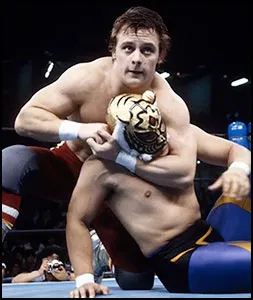 Billington’s success was even greater in Japan than in Canada. In the Land of the Rising Sun, The Dynamite Kid was a genuine top-level superstar within the brand-new and highly popular I.W.G.P. Junior Heavyweight division during its formative years in the early 1980s. So, when the heavily-favored Kid was upset by the debuting (and soon to be legendary) Tiger Mask on January 1, 1982, it created major shockwaves within NJPW The historic feud between Tiger Mask and The Dynamite Kid was truly as innovative, exciting and trend-setting as anything taking place in the world of pro wrestling at that time and their classic matches laid the groundwork for a style of wrestling that continues to this day.
Billington’s success was even greater in Japan than in Canada. In the Land of the Rising Sun, The Dynamite Kid was a genuine top-level superstar within the brand-new and highly popular I.W.G.P. Junior Heavyweight division during its formative years in the early 1980s. So, when the heavily-favored Kid was upset by the debuting (and soon to be legendary) Tiger Mask on January 1, 1982, it created major shockwaves within NJPW The historic feud between Tiger Mask and The Dynamite Kid was truly as innovative, exciting and trend-setting as anything taking place in the world of pro wrestling at that time and their classic matches laid the groundwork for a style of wrestling that continues to this day.
While in New Japan, Billington won the WWF World Junior Heavyweight title on February 7, 1984 and in 1985, after jumping to All Japan Pro Wrestling, he captured the NWA International Junior Heavyweight title. At the same time, back in Calgary, The Kid was squaring off in a heated feud with the young man who would soon accompany him to unforeseen fame, Davey Boy Smith. Billington and Smith, cousins, were intense rivals prior to their legendary tag team and the two Junior Heavyweights (the heavily-muscled Smith was much smaller during this period of time, as was The Kid) wrestled in cities all across the Stampede territory in a feud that thrilled fans and drew impressive crowds for Stampede. However, when they put their storyline differences aside and formed a tag team, the careers of both men skyrocketed to new heights.
The British Bulldogs are generally thought of as one of the greatest tag teams of the late twentieth century, and their combination of precise teamwork, agility, stealth and power was a model for all other tag teams, both in North America and Japan. While their one WWF World Tag Team title reign lasted just nine months (a relatively short reign for that period of time) the team made a profound impact during their three-year stay in the WWF, as well as during their tours of both New Japan and All Japan. Although their pure wrestling ability was often overshadowed by the cartoonish aspect of the wrestlers who made up the WWF roster during the mid-1980s, the Bulldogs’ incredible ring work consistently made fans notice them, until the promotion had no choice but to give them a title run. The British Bulldogs were an exemplary tag team and true crowd-pleasers that the WWF’s bookers could always count on to deliver a high-quality match. Unfortunately for most of the WWF’s roster of one-dimensional giants in the mid 1980s, going on after The Bulldogs could (and did) expose their lack of ring technique to the fans, who, after being blown away by the intensity and skill of a Bulldogs vs. Hart Foundation battle, would often sit on their hands during other matches on the card.
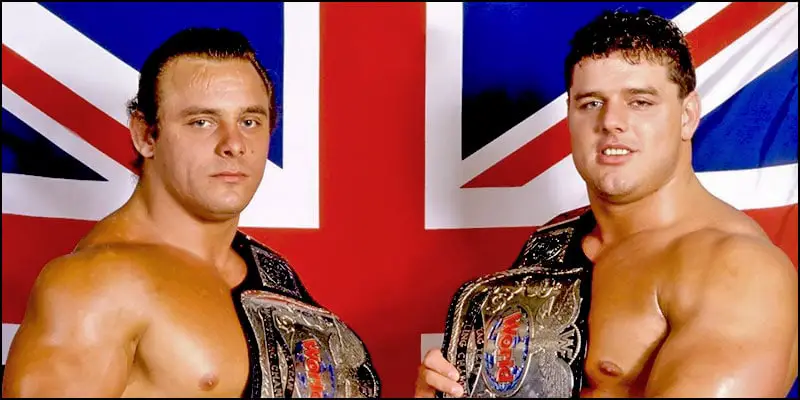
So, when the British Bulldogs abruptly left the WWF in 1988, returning “home” to Stampede Wrestling, the move from the World Wrestling Federation to Stampede was a bit of a shock to wrestling fans. After all, the WWF was at the height of its fame and power, and Stampede Wrestling, while respected, drew crowds that often would not exceed even 1,000 people. What fans didn’t realize at the time was that behind the scenes at the WWF, the abrasive, short-tempered Billington had burned many bridges with both wrestlers and front office personnel, making his exit inevitable. Nevertheless, the world famous British Bulldogs returned to the Calgary mat wars, as well as travelling to the AWA’s Central States promotion (after the territory had withdrawn from the NWA) to take on The Rock `N Roll Express in what was billed as a tag team “dream match.” The former respective NWA and WWF World Tag Team champions never really settled the question of who was the better team, but their brief mini-feud was still a independent wrestling highlight of the late 1980s.
 Back in Calgary, Smith and Billington had a bitter falling out that saw The Kid not only turning his back on his cousin and longtime partner, but also his loyal fans. As the story developed, Davey Boy’s cousin Johnny Smith was recruited into the war by The Kid, and they formed The British Bruisers. The Billington vs. Smith feud was shaping up to be the main attraction of Stampede for the foreseeable future, however, Davey Boy was unexpectedly involved in a serious car wreck which took him out of the picture for quite some time, effectively ending their feud before it really got started. In many ways, Stampede’s Bulldog vs. Bulldog program was a storyline portrayal of the real-life personal and professional conflicts that slowly developed between the longtime partners. Their bitter falling-out sadly resulted in the cousins (and their respective families) refusing to speak to each other for over twenty years and, regrettably, Smith passed away before a reconciliation between the two could take place.
Back in Calgary, Smith and Billington had a bitter falling out that saw The Kid not only turning his back on his cousin and longtime partner, but also his loyal fans. As the story developed, Davey Boy’s cousin Johnny Smith was recruited into the war by The Kid, and they formed The British Bruisers. The Billington vs. Smith feud was shaping up to be the main attraction of Stampede for the foreseeable future, however, Davey Boy was unexpectedly involved in a serious car wreck which took him out of the picture for quite some time, effectively ending their feud before it really got started. In many ways, Stampede’s Bulldog vs. Bulldog program was a storyline portrayal of the real-life personal and professional conflicts that slowly developed between the longtime partners. Their bitter falling-out sadly resulted in the cousins (and their respective families) refusing to speak to each other for over twenty years and, regrettably, Smith passed away before a reconciliation between the two could take place.
Although Davey Boy Smith would go on to have a long career that would see him gain solo success in both the WWF and WCW, Tom “The Dynamite Kid” Billington’s storied career was about to end. After fifteen years in the ring, employing his high-impact, daredevil style, The Kid was simply no longer the wrestler he had once been. The years of injuries, surgeries and abuse of his body finally took their toll and Billington’s back was simply too battered to continue wrestling. Regrettably, the career of one of the greatest Junior Heavyweight and Tag Team wrestlers in the history of the sport was forced to come to a premature end. Eventually, Billington became essentially bed-ridden and wheel chair-bound, partially paralyzed due to complications from a series of injuries.
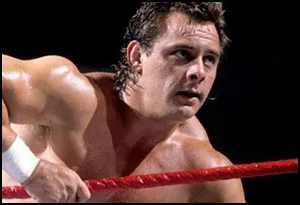 Fittingly, The Dynamite Kid’s influence is still being felt in the styles, techniques and maneuvers of current wrestlers. It is no coincidence that those who have adopted The Kid’s style and execution of moves are regarded as some of the most exciting, believable wrestlers currently in the business. A genuine trailblazer, his undeniable importance to the sport in both the lightweight and tag team divisions is frequently overlooked by contemporary fans, despite its legitimacy. So much more than just “the other British Bulldog,” in his day, The Dynamite Kid, with his precise timing, razor-sharp delivery, and ability to make everything happening in the ring seem completely “real,” was literally as good as it got inside of the squared circle.
Fittingly, The Dynamite Kid’s influence is still being felt in the styles, techniques and maneuvers of current wrestlers. It is no coincidence that those who have adopted The Kid’s style and execution of moves are regarded as some of the most exciting, believable wrestlers currently in the business. A genuine trailblazer, his undeniable importance to the sport in both the lightweight and tag team divisions is frequently overlooked by contemporary fans, despite its legitimacy. So much more than just “the other British Bulldog,” in his day, The Dynamite Kid, with his precise timing, razor-sharp delivery, and ability to make everything happening in the ring seem completely “real,” was literally as good as it got inside of the squared circle.
 In 1991, The Dynamite Kid received Tokyo Sports’ Lifetime Achievement Award and he is a member of the Stampede Wrestling Hall of Fame (1995), the Wrestling Observer Newsletter Hall of Fame (1996) and the Canadian Wrestling Hall of Fame (2001).
In 1991, The Dynamite Kid received Tokyo Sports’ Lifetime Achievement Award and he is a member of the Stampede Wrestling Hall of Fame (1995), the Wrestling Observer Newsletter Hall of Fame (1996) and the Canadian Wrestling Hall of Fame (2001).
Tom “The Dynamite Kid” Billington passed away on his 60th birthday, December 5, 2018.
by Stephen Von Slagle
In the early days of organized professional wrestling, charisma and marketability were already surpassing wrestling skill as the primary assets a wrestler could possess. During the Twenties, Thirties and Forties, the sport certainly featured a much more realistic look & feel, entirely because pro wrestling was supposed to be a legitimate sport, even though it no longer was. The bottom line of professional wrestling has always been just that; the bottom line. As the stakes were raised and the popularity of wrestling grew, it became clear to promoters that, while grappling prowess & ability was absolutely a requirement for success, pure ring skill was no longer the be-all, end-all of the mat game. At least not when it came to drawing paying fans to the show, which was/is the sole purpose of presenting a wrestling card. While it may be accurate to say that there were other wrestlers more talented inside of the ring than NFL superstar-turned-pro wrestler, the legendary Bronko Nagurski, few, if any, carried the same kind of name recognition and mainstream popularity that the famous former Chicago Bear enjoyed. However, as previously noted, pro wrestling greatness is determined by a performer’s ability to draw money, and exceptional in-ring ability is not always a sure-fire ticket to success. That said, Nagurski, a natural athlete in the truest sense of the term, never had any amateur experience as a wrestler but became a more-than-competent worker after his career as a football player ended. The combination of his acquired wrestling fundamentals, which eventually became quite solid, and brute strength (not to mention his famous name) eventually resulted in not one, but several reigns as the World Heavyweight champion for Nagurski. During the Thirties and Forties, Bronko was unquestionably one the biggest names in wrestling and he was among the most famous athletes (of any sport) in the country.
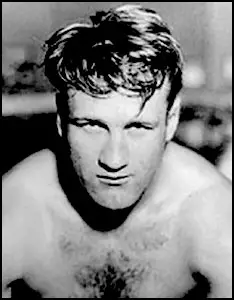 Bronislau “Bronko” Nagurski was born on November 3, 1908 in Canada, but while still a toddler, his family moved to Minnesota and he spent the rest of his youth growing up in the States. From the start, Nagurski excelled at sports, and in particular, football. After graduating from high school, he attended the University of Minnesota and continued his amateur career in football, with great success. Nagurski, an All-American at the University of Minnesota from 1927 through 1929, quickly established himself as the best defensive player in the Big Ten, and perhaps the country. A testament to his unique talents, Nagurski was the only athlete in American collegiate history to become an All-Star at two different positions, Tackle and Full-back. Understandably, it didn’t take long for the National Football League to gain an interest in Nagurski and in 1930, his lifelong dream came true when he was approached by the legendary George Halas with a contract that enabled him to become a professional football player. Not only that, Nagurski was signed to one of the most respected and successful teams in N.F.L. history, the Chicago Bears. Halas’ newest defensive mauler quickly proved his worth, and Nagurski was the focal point of one of the greatest defensive squads ever, helping to lead the mighty Chicago Bears to the World championship in 1932. The next season, Nagurski’s “Monsters of the Midway” continued where they had left off, repeating as the 1933 World champions. The team’s back-to-back World championships and its complete dominance of the opposition placed them in an elite class of history’s best N.F.L. squads, and the Chicago Bears of the early Thirties, led by their star defensive player Bronko Nagurski, will forever be remembered as one of the greatest in the rich history of the National Football League.
Bronislau “Bronko” Nagurski was born on November 3, 1908 in Canada, but while still a toddler, his family moved to Minnesota and he spent the rest of his youth growing up in the States. From the start, Nagurski excelled at sports, and in particular, football. After graduating from high school, he attended the University of Minnesota and continued his amateur career in football, with great success. Nagurski, an All-American at the University of Minnesota from 1927 through 1929, quickly established himself as the best defensive player in the Big Ten, and perhaps the country. A testament to his unique talents, Nagurski was the only athlete in American collegiate history to become an All-Star at two different positions, Tackle and Full-back. Understandably, it didn’t take long for the National Football League to gain an interest in Nagurski and in 1930, his lifelong dream came true when he was approached by the legendary George Halas with a contract that enabled him to become a professional football player. Not only that, Nagurski was signed to one of the most respected and successful teams in N.F.L. history, the Chicago Bears. Halas’ newest defensive mauler quickly proved his worth, and Nagurski was the focal point of one of the greatest defensive squads ever, helping to lead the mighty Chicago Bears to the World championship in 1932. The next season, Nagurski’s “Monsters of the Midway” continued where they had left off, repeating as the 1933 World champions. The team’s back-to-back World championships and its complete dominance of the opposition placed them in an elite class of history’s best N.F.L. squads, and the Chicago Bears of the early Thirties, led by their star defensive player Bronko Nagurski, will forever be remembered as one of the greatest in the rich history of the National Football League.
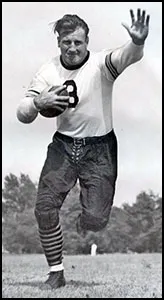 Despite the success and fame he gained as a Chicago Bear, the fact of the matter was pro football players were not highly paid at that time and, on the heels of winning his second World Championship with the Bears, Nagurski made headlines with his professional wrestling debut in 1933. He competed for several years as a two-sport star, but with his N.F.L. career winding down, and seeing the type of income he could earn as a wrestler, Nagurski eventually started wrestling more and more. Taking the advice of the reigning World champion at the time, Lou Thesz, Nagurski retired from football and began a full-time career as a professional wrestler. Under the tutelage of Minnesota promoter Tony Stecher, Bronko won his first major wrestling championship when he defeated Dean Detton and captured the Maryland version of the World Heavyweight title on June 16, 1937. Although the Maryland version of the World championship was one of several World titles being defended at the time, it was also one of the more prestigious titles of the day, and the well-known Nagurski not only benefited from his first championship, but the title itself gained credibility by having Bronko carry it. However, when he refused to grant a title shot to former champion Jim Londos, Nagurski was stripped of the title and the championship was vacated.
Despite the success and fame he gained as a Chicago Bear, the fact of the matter was pro football players were not highly paid at that time and, on the heels of winning his second World Championship with the Bears, Nagurski made headlines with his professional wrestling debut in 1933. He competed for several years as a two-sport star, but with his N.F.L. career winding down, and seeing the type of income he could earn as a wrestler, Nagurski eventually started wrestling more and more. Taking the advice of the reigning World champion at the time, Lou Thesz, Nagurski retired from football and began a full-time career as a professional wrestler. Under the tutelage of Minnesota promoter Tony Stecher, Bronko won his first major wrestling championship when he defeated Dean Detton and captured the Maryland version of the World Heavyweight title on June 16, 1937. Although the Maryland version of the World championship was one of several World titles being defended at the time, it was also one of the more prestigious titles of the day, and the well-known Nagurski not only benefited from his first championship, but the title itself gained credibility by having Bronko carry it. However, when he refused to grant a title shot to former champion Jim Londos, Nagurski was stripped of the title and the championship was vacated.
Having established himself as one of the wrestling’s top box-office draws, Bronko bounced back by gaining an even more prestigious World championship, the National Wrestling Association World Heavyweight title, by defeating Thesz on June 23, 1939 in Houston, TX. Over the course of the following nine months, the famous NWA World champion (and the promoters who had Nagurski wrestling on their card) enjoyed a great deal of success as he traveled the country defending his version of the World title. And, while there were other claimants to the World Championship also defending their belts at the same time as Bronko, his stature among the public was nearly unrivaled and the man who The Ring (once the most popular wrestling/boxing magazine in the country) referred to as “the true World champion” was, indeed, respected by all.
The rugged Nagurski eventually lost his NWA World title to Ray Steele on March 7, 1940 in St. Louis, Missouri, and spent the next year enjoying the reduced schedule of a non-champion. However, almost one year to the day since his loss of the title, Nagurski regained the National Wrestling Association World championship from Steele in Minneapolis, and he again became the reigning World champion. However, several months later, Nagurski was upset by Sandor Szabo on June 5, 1941. Although no one could have known it at the time, the loss, which took place in St. Louis, Missouri, would mark the end of The Bronko’s run as the World Heavyweight champion. It did not, however, end his career and Nagurski continued on as one of the top box-office draws in the business. In October of 1946, Nagurski, by now a seasoned ring veteran, gained some measure of revenge when he captured the National Wrestling Alliance’s Pacific Coast championship by defeating Sandor Szabo, the same man who had taken Bronko’s World title five years earlier. During their respective careers, Nagurski and Szabo met numerous times in the ring, with each man taking his share of victories (and championships) from the other. After dropping the Pacific Coast title to Billy Hansen several weeks after his win over Szabo, Bronko regained the once-prestigious title by defeating Len Hall on October 1, 1948 in Oakland, CA. However, just three weeks later, Szabo once again scored a win over his popular rival, and regained the Pacific Coast title as a result of his victory over Nagurski.
 As the Forties became the Fifties, Nagurski entered his third separate decade in the wrestling business. Considering the punishment his body had taken during his career as a Chicago Bear and then as a World champion wrestler, it’s not surprising that the battered Nagurski began to slow a step or two. Still, in the world of professional wrestling, experience can often overcome youth, and Nagurski remained a top name (and champion) in the business. After years as a singles performer, Nagurski returned to “team sports” when he formed a highly successful duo with one of the brightest young stars in the business at the time, former N.C.A.A. champion Verne Gagne. Their team, which embodied youth & experience as well as science & power, became a big draw that was highly popular. This was even more the case after the duo won the World Tag Team title on December 26, 1957 by defeating the hated combo of Johnny Valentine & Chet Wallich. Nagurski and Gagne enjoyed a great deal of success during their lengthy reign as the tag champions before they finally lost their title belts to the brother combo of Doc and Mike Gallagher on March 22, 1958 in St, Paul, MN.
As the Forties became the Fifties, Nagurski entered his third separate decade in the wrestling business. Considering the punishment his body had taken during his career as a Chicago Bear and then as a World champion wrestler, it’s not surprising that the battered Nagurski began to slow a step or two. Still, in the world of professional wrestling, experience can often overcome youth, and Nagurski remained a top name (and champion) in the business. After years as a singles performer, Nagurski returned to “team sports” when he formed a highly successful duo with one of the brightest young stars in the business at the time, former N.C.A.A. champion Verne Gagne. Their team, which embodied youth & experience as well as science & power, became a big draw that was highly popular. This was even more the case after the duo won the World Tag Team title on December 26, 1957 by defeating the hated combo of Johnny Valentine & Chet Wallich. Nagurski and Gagne enjoyed a great deal of success during their lengthy reign as the tag champions before they finally lost their title belts to the brother combo of Doc and Mike Gallagher on March 22, 1958 in St, Paul, MN.
With decades’ worth of intense physical punishment finally beginning to take a toll of his body, the battered Nagurski made the decision to retire in 1960 following one of the most memorable athletic careers of modern times. After nearly three decades in the wrestling business, Nagurski hung his wrestling gear up and returned home to a quiet life in rural Minnesota.
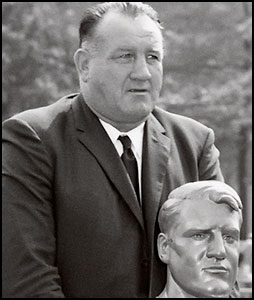 Considering his many accomplishments as a football player (both amateur and pro) it’s not surprising that Bronko Nagurski is a member of the N.F.L. Hall of Fame. Another tribute to his long-term impact is the annual Bronko Nagurski Award, an honor that is voted on by the Football Writers Association of America (F.W.A.A.) and given to the top amateur defensive football player in the country.
Considering his many accomplishments as a football player (both amateur and pro) it’s not surprising that Bronko Nagurski is a member of the N.F.L. Hall of Fame. Another tribute to his long-term impact is the annual Bronko Nagurski Award, an honor that is voted on by the Football Writers Association of America (F.W.A.A.) and given to the top amateur defensive football player in the country.
Bronko Nagurski is a member of the Wrestling Observer Newsletter Hall of Fame (1996), the International Wrestling Institute & Museum’s George Tragos/Lou Thesz Professional Wrestling Hall of Fame (2009) and the Professional Wrestling Hall of Fame and Museum (2011).
Bronislau “Bronko” Nagurski passed away on January 8, 1990 at the age of 82.
by Stephen Von Slagle
The legendary Frank “Bruiser Brody” Goodish was one of the wildest brawlers ever to step inside of a pro wrestling ring and, outside of it, he was a rebel like few others. The 6`5″ 320 lb. New Mexican madman, with long curly black hair, scraggly beard and furry boots brawled with such reckless abandon and fury that he became a true legend in every country he performed. His style and image have been emulated more times than can be counted, which is more a tribute to his unique originality than blatant copying. It can be argued that Bruiser Brody was one of the greatest, if not the greatest, brawlers the sport has ever known. But his story, unfortunately, is also one of wrestling’s most tragic.
Although billed as hailing from Albuquerque, New Mexico, Frank Goodish was born in Pennsylvania in 1946, moved to Michigan during his youth, and attended both Iowa State and, later, West Texas State, playing defensive end on their respective football teams. Following college, he had stints with both the Washington Redskins and Edmonton Eskimos and while he had more than enough athletic ability to make it as a pro football player, team sports was not the forte of the fiercely individualistic, undisciplined Goodish. Luckily, he soon found his calling in the chaotic world of professional wrestling.
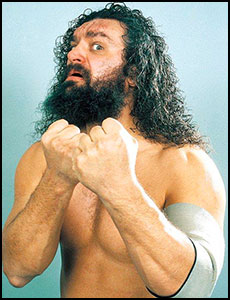 He began his career in 1973 working for Leroy McGuirk and by September of the following year he won his first championship, the NWA United States Tag Team title (Tri-State version) with Stan Hansen. After finishing up with McGuirk, he travelled to Dallas and, later, the Florida territory, where he quickly became a headliner and the Florida Heavyweight champion. In 1975, with less than two years under his belt, Goodish was brought to the World Wide Wrestling Federation by Vince McMahon, Sr., given the name “Bruiser” Frank Brody, and programmed into a main-event feud with the legendary WWWF champion Bruno Sammartino. His run in the northeast was ultimately short-lived, though, as Brody became involved in a backstage altercation with Gorilla Monsoon, a member of the promotion’s management team, and was immediately let go by the Federation. It was not an isolated incident, as behind the scenes Brody was often even more unpredictable than he was inside the ring. A genuine outlaw who was never afraid to stand up for himself when he felt slighted by those in power, he was known to frequently ignore the orders of management and occasionally leave promoters in some very awkward situations. Yet despite (or, perhaps, because of) the controversy he created, the highly-talented, massive Brody was a bonafide, consistent box-office success.
He began his career in 1973 working for Leroy McGuirk and by September of the following year he won his first championship, the NWA United States Tag Team title (Tri-State version) with Stan Hansen. After finishing up with McGuirk, he travelled to Dallas and, later, the Florida territory, where he quickly became a headliner and the Florida Heavyweight champion. In 1975, with less than two years under his belt, Goodish was brought to the World Wide Wrestling Federation by Vince McMahon, Sr., given the name “Bruiser” Frank Brody, and programmed into a main-event feud with the legendary WWWF champion Bruno Sammartino. His run in the northeast was ultimately short-lived, though, as Brody became involved in a backstage altercation with Gorilla Monsoon, a member of the promotion’s management team, and was immediately let go by the Federation. It was not an isolated incident, as behind the scenes Brody was often even more unpredictable than he was inside the ring. A genuine outlaw who was never afraid to stand up for himself when he felt slighted by those in power, he was known to frequently ignore the orders of management and occasionally leave promoters in some very awkward situations. Yet despite (or, perhaps, because of) the controversy he created, the highly-talented, massive Brody was a bonafide, consistent box-office success.
His championship accolades include the NWA Western States title in 1975, four Mid South North American championships, three Texas Tag Team titles between 1977-1979, the Texas Heavyweight title, the Texas Brass Knuckles title, four American Tag Team championships (three w/Kerry Von Erich and one w/Ernie Ladd), the Central States Tag Team title (w/Ladd) and the Central States Heavyweight title in 1980. He also captured three NWA International Heavyweight championships between 1981-1988, the Australian World Brass Knuckles title, the World Wrestling Association World Heavyweight title, the PWF Tag Team championship (w/Hansen), the WCCW TV title in 1986 and the NWF International Heavyweight title in 1987.
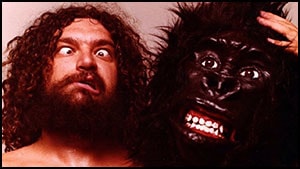 During his fifteen years in the sport, Brody wrestled both as a hated villain and a tough-as-nails babyface without ever changing his in-ring style. At the same time, he feuded with the very best in the sport, most notable are his heated rivalries with Antonio Inoki, the Von Erich family, the Funk brothers, NWA World champions Flair, Race & Rhodes and, of course, his bloody wars with Abdullah the Butcher, which took place throughout the U.S., Japan and Puerto Rico. One of his more memorable feuds was against the mammoth Andre the Giant. At 6’5″ (he was often billed as standing 6’8″) and 320 lbs., Brody was a legitimate physical challenge for Andre and he gave the Giant some of the toughest matches of his career throughout regions across the wrestling map during their multi-year feud. Another major program for Brody was his lengthy series against the legendary Dick The Bruiser, which took place in several midwestern promotions including St. Louis, Central States, the AWA and the WWA Their ongoing feud eventually led to “blow-off” matches in major cities within these various promotions, with the two brawlers fighting over the right to use the name “Bruiser.” Brody lost, and was known as “King Kong” Brody, at least throughout the Midwest, for the rest of his career.
During his fifteen years in the sport, Brody wrestled both as a hated villain and a tough-as-nails babyface without ever changing his in-ring style. At the same time, he feuded with the very best in the sport, most notable are his heated rivalries with Antonio Inoki, the Von Erich family, the Funk brothers, NWA World champions Flair, Race & Rhodes and, of course, his bloody wars with Abdullah the Butcher, which took place throughout the U.S., Japan and Puerto Rico. One of his more memorable feuds was against the mammoth Andre the Giant. At 6’5″ (he was often billed as standing 6’8″) and 320 lbs., Brody was a legitimate physical challenge for Andre and he gave the Giant some of the toughest matches of his career throughout regions across the wrestling map during their multi-year feud. Another major program for Brody was his lengthy series against the legendary Dick The Bruiser, which took place in several midwestern promotions including St. Louis, Central States, the AWA and the WWA Their ongoing feud eventually led to “blow-off” matches in major cities within these various promotions, with the two brawlers fighting over the right to use the name “Bruiser.” Brody lost, and was known as “King Kong” Brody, at least throughout the Midwest, for the rest of his career.
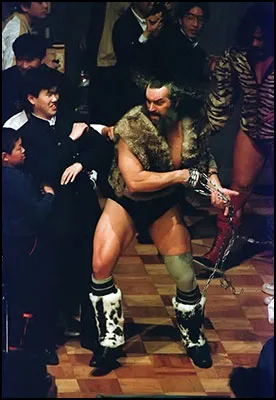 After making his Japanese debut in a tag match with Curtis Iukea vs. Giant Baba and The Masked Destroyer in January of 1979, Brody quickly created a second home for himself in the Land of the Rising Sun. Wrestling with a fury and unpredictability that Japanese fans had never witnessed before, Brody became a legitimate superstar there, a mainstream Japanese celebrity and one of the highest paid wrestlers in the world. The chaos that the gigantic American brawler created just getting to the ring, wildly, dangerously, swinging his heavy steel chain overheard as the audience frantically scrambled in fear and delight, was truly the stuff of legend. Inside the ring, he exhibited the same reckless abandon, often alongside his equally unpredictable partner Stan Hansen. After more than five years competing in Shohei Baba’s All Japan promotion, Brody eventually made a very controversial, unexpected, high-dollar jump to Inoki’s New Japan group and his fame and success followed.
After making his Japanese debut in a tag match with Curtis Iukea vs. Giant Baba and The Masked Destroyer in January of 1979, Brody quickly created a second home for himself in the Land of the Rising Sun. Wrestling with a fury and unpredictability that Japanese fans had never witnessed before, Brody became a legitimate superstar there, a mainstream Japanese celebrity and one of the highest paid wrestlers in the world. The chaos that the gigantic American brawler created just getting to the ring, wildly, dangerously, swinging his heavy steel chain overheard as the audience frantically scrambled in fear and delight, was truly the stuff of legend. Inside the ring, he exhibited the same reckless abandon, often alongside his equally unpredictable partner Stan Hansen. After more than five years competing in Shohei Baba’s All Japan promotion, Brody eventually made a very controversial, unexpected, high-dollar jump to Inoki’s New Japan group and his fame and success followed.
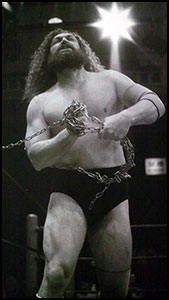 As was the case everywhere he wrestled, Bruiser Brody was one of the biggest stars and box-office draws in the Puerto Rican-based World Wrestling Council, where he had legendary matches with Abdullah and Carlos Colon. But his feud with the Masked Invader (Jose Gonzalez, co-owner of the WWC) proved to be the last of his career. The events that took place in Puerto Rico the summer of 1988 have been well-documented in books, documentaries and television programs. On July 17, 1988, Frank Goodish a.k.a. Bruiser Brody was murdered in a Puerto Rican locker room, the victim of several stab wounds to the abdominal area. He was 42 years old.
As was the case everywhere he wrestled, Bruiser Brody was one of the biggest stars and box-office draws in the Puerto Rican-based World Wrestling Council, where he had legendary matches with Abdullah and Carlos Colon. But his feud with the Masked Invader (Jose Gonzalez, co-owner of the WWC) proved to be the last of his career. The events that took place in Puerto Rico the summer of 1988 have been well-documented in books, documentaries and television programs. On July 17, 1988, Frank Goodish a.k.a. Bruiser Brody was murdered in a Puerto Rican locker room, the victim of several stab wounds to the abdominal area. He was 42 years old.
Jose Gonzalez was charged with the murder, to which there were several eyewitnesses. Tony Atlas, in a statement to police at the time, told the authorities that Gonzalez had approached Brody, asked to speak with him in the shower area, and that Gonzales had then stabbed Goodish in the torso several times. Atlas also stated that Gonzalez attempted to slit Brody’s throat.
Gonzales, stating that he was acting in self-defense, plead not guilty. Unlike in the United States, the jury in a Puerto Rican murder case does not have to come to a unanimous decision, and whichever way the majority of the jury votes is how the verdict is rendered. Although Puerto Rican law came to a different conclusion, most familiar with the case believe Brody’s murderer walked away a free man.
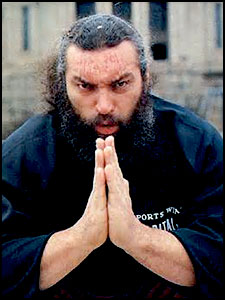 The news of Brody’s murder sent shockwaves through the world of wrestling and the World Wrestling Council, once a true promotional hotbed, all but disappeared after the fallout from negative publicity, not to mention the devastating loss of American talent who refused to work in Puerto Rico after Brody’s murder. But the loss of the WWC as a major territory pales in comparison to the loss the sport, and more so, his family, suffered when Frank Goodish died. Professional wrestling lost a true legend on that steamy July night, the likes of which we may never see again.
The news of Brody’s murder sent shockwaves through the world of wrestling and the World Wrestling Council, once a true promotional hotbed, all but disappeared after the fallout from negative publicity, not to mention the devastating loss of American talent who refused to work in Puerto Rico after Brody’s murder. But the loss of the WWC as a major territory pales in comparison to the loss the sport, and more so, his family, suffered when Frank Goodish died. Professional wrestling lost a true legend on that steamy July night, the likes of which we may never see again.
“King Kong” Bruiser Brody was voted “Best Brawler” by the readers of the Wrestling Observer Newsletter an unprecedented seven times between 1980-1988. Following his death, the “Best Brawler” award was renamed the Bruiser Brody Memorial Award. Additionally, the renowned Japanese daily sports newspaper, Tokyo Sports, honored Brody with its Lifetime Achievement Award (1988) and he was chosen to receive the prestigious Frank Gotch Award by the George Tragos/Lou Thesz Professional Wrestling Hall of Fame (2018). Brody is also a member of the Wrestling Observer Hall of Fame (1996), the St. Louis Wrestling Hall of Fame (2007), the Professional Wrestling Hall of Fame (2014), and the W.W.E. Hall of Fame (2019).
by Stephen Von Slagle
Ed Lewis was a true pioneer of the sport and one of its earliest and most dominant champions. He truly paved the road for pro wrestling to be recognized as a legitimate sport in the eyes of the public during the early 20th century, and he was also there to see the fallout of the sport’s dark “legitimacy” secret revealed to that trusting public. This multiple-time World Champion (and expert submission wrestler) helped, as part of the influential Gold Dust Trio with partners Billy Sandow and Toots Mondt, to introduce what are now considered pro wrestling norms, forever changing the sport, and for that, the professional wrestling will always owe him a debt of gratitude.
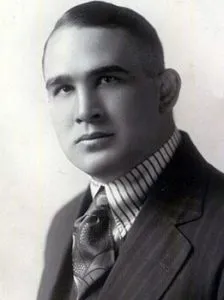 “The Strangler” was not born Ed Lewis, but rather, Robert Friedrich on June 30, 1891. Like many future Hall of Famers from this time period, he started wrestling at a very young age, fourteen, by which time he already weighed nearly 200 pounds. During this early, developmental time of his career, Friedrich competed at small carnivals, gaining valuable experience in farm towns throughout middle America. The sport of wrestling was very different during those early formative years and in the late nineteenth/early twentieth centuries there were still many actual professional wrestling contests or “shoots” (although the concept of a “predetermined winner” was certainly not unheard of) with most matches decided in 2 out of 3 fall contests. The emphasis of the wrestlers back then was not necessarily to draw and entertain tens of thousands of fans by incorporating wild gimmicks and costumes, but rather, simply to gain the advantage over, and then defeat, your opponent through leverage, fighting skills, and grappling…and still turn a profit. When Lewis first started in the sport, a “work” was considered by many top names of the era to be very much beneath their dignity, although the pre-determined match was beginning to be used by promoters more and more frequently. In the late 1800s and early 1900s, most (but far from all) pro wrestling matches were still, indeed, legitimate contests between two wrestlers who were each trying to defeat the other. Lewis himself was involved in arguably the longest running wrestling match in history, when on July 4, 1916 he wrestled former champion Joe Stecher to a 5 1/2 hour draw. Often referring disdainfully to wrestling that incorporated wild personalities and choreography as “slambang” wrestling, Lewis began his career just prior to the slow transition that forever led professional wrestling down the road of “sports entertainment.”
“The Strangler” was not born Ed Lewis, but rather, Robert Friedrich on June 30, 1891. Like many future Hall of Famers from this time period, he started wrestling at a very young age, fourteen, by which time he already weighed nearly 200 pounds. During this early, developmental time of his career, Friedrich competed at small carnivals, gaining valuable experience in farm towns throughout middle America. The sport of wrestling was very different during those early formative years and in the late nineteenth/early twentieth centuries there were still many actual professional wrestling contests or “shoots” (although the concept of a “predetermined winner” was certainly not unheard of) with most matches decided in 2 out of 3 fall contests. The emphasis of the wrestlers back then was not necessarily to draw and entertain tens of thousands of fans by incorporating wild gimmicks and costumes, but rather, simply to gain the advantage over, and then defeat, your opponent through leverage, fighting skills, and grappling…and still turn a profit. When Lewis first started in the sport, a “work” was considered by many top names of the era to be very much beneath their dignity, although the pre-determined match was beginning to be used by promoters more and more frequently. In the late 1800s and early 1900s, most (but far from all) pro wrestling matches were still, indeed, legitimate contests between two wrestlers who were each trying to defeat the other. Lewis himself was involved in arguably the longest running wrestling match in history, when on July 4, 1916 he wrestled former champion Joe Stecher to a 5 1/2 hour draw. Often referring disdainfully to wrestling that incorporated wild personalities and choreography as “slambang” wrestling, Lewis began his career just prior to the slow transition that forever led professional wrestling down the road of “sports entertainment.”
Lewis got his “Strangler” nickname, according to legend, from a reporter who saw a similarity between a rookie Lewis and the former champion Evan “The Strangler” Lewis. Ed Lewis used a variation of what is now known as the Sleeper hold, which appeared to the public at the time as though he was strangling his opponent. Lewis, probably the most accomplished submission wrestler in the sport during the early 1900s, was feared and respected both inside and outside of the ring for his extensive knowledge of amateur wrestling, and even more for his wide array of crippling wrestling holds known as “hooks.” All of the wrestlers knew that Ed Lewis easily could, and sometimes did, legitimately injure any wrestler that crossed him, anytime he felt like it.
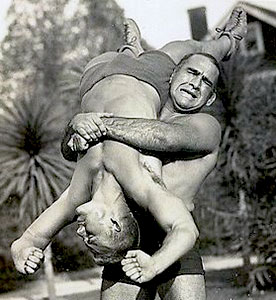 Among the many titles he would win were no less than four undisputed World Heavyweight championships between 1920-1931 (holding the title for five out of those eleven years) and was the World Champion with the most number of title reigns for the next thirty years, until his future protégé Lou Thesz broke the record. He also won the AWA (Boston) World Heavyweight title and unified that with the Undisputed World championship. However, on April 14, 1931 he lost the AWA championship via DQ in a very controversial match to Henri Deglane, ultimately becoming the first step in what would eventually once again shatter the World title into many different versions. However, he was still recognized as the World champion in Chicago, then the center of the wrestling world, and in most other wrestling hotbeds across the country. He won the New York State Athletic Commission (N.Y.S.A.C.) World Heavyweight title in 1932, and re-established himself to East Coast fans as the true World Champion. Ten years later, on November 26, 1942, he defeated Orville Brown for the Midwest Wrestling Association World Heavyweight title in Kansas City, KS.
Among the many titles he would win were no less than four undisputed World Heavyweight championships between 1920-1931 (holding the title for five out of those eleven years) and was the World Champion with the most number of title reigns for the next thirty years, until his future protégé Lou Thesz broke the record. He also won the AWA (Boston) World Heavyweight title and unified that with the Undisputed World championship. However, on April 14, 1931 he lost the AWA championship via DQ in a very controversial match to Henri Deglane, ultimately becoming the first step in what would eventually once again shatter the World title into many different versions. However, he was still recognized as the World champion in Chicago, then the center of the wrestling world, and in most other wrestling hotbeds across the country. He won the New York State Athletic Commission (N.Y.S.A.C.) World Heavyweight title in 1932, and re-established himself to East Coast fans as the true World Champion. Ten years later, on November 26, 1942, he defeated Orville Brown for the Midwest Wrestling Association World Heavyweight title in Kansas City, KS.
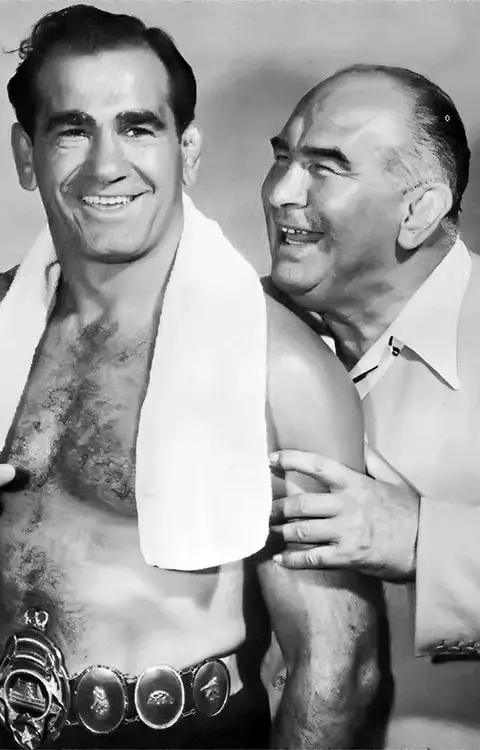 During the height of his popularity, he was a sports celebrity ranking with the likes of baseball’s Babe Ruth and boxing’s Jack Dempsey. In an era when the general public truly believed in professional wrestling’s legitimacy, Ed “Strangler” Lewis was among the sports/entertainment elite, enjoying unbridled fame, having close personal friendships with Ruth and other world-famous celebrities, and earning millions of dollars at a time of economic strife for the rest of the country. According to many sports and entertainment historians, at one point, Ed “Strangler” Lewis was arguably the top sports celebrity in America. In fact, Lewis and boxing champion Jack Dempsey had a long-running “feud” throughout their simultaneous title reigns, mainly fueled by the press, who were looking for a story, and fans who clamored for a dream matchup between the two popular celebrity athletes. However, nothing ever came of the speculation and newspaper “war of the words” between the two champions, despite Lewis’ willingness. Dempsey later admitted that the match never happened because he knew that he didn’t stand a chance against the World wrestling champion.
During the height of his popularity, he was a sports celebrity ranking with the likes of baseball’s Babe Ruth and boxing’s Jack Dempsey. In an era when the general public truly believed in professional wrestling’s legitimacy, Ed “Strangler” Lewis was among the sports/entertainment elite, enjoying unbridled fame, having close personal friendships with Ruth and other world-famous celebrities, and earning millions of dollars at a time of economic strife for the rest of the country. According to many sports and entertainment historians, at one point, Ed “Strangler” Lewis was arguably the top sports celebrity in America. In fact, Lewis and boxing champion Jack Dempsey had a long-running “feud” throughout their simultaneous title reigns, mainly fueled by the press, who were looking for a story, and fans who clamored for a dream matchup between the two popular celebrity athletes. However, nothing ever came of the speculation and newspaper “war of the words” between the two champions, despite Lewis’ willingness. Dempsey later admitted that the match never happened because he knew that he didn’t stand a chance against the World wrestling champion.
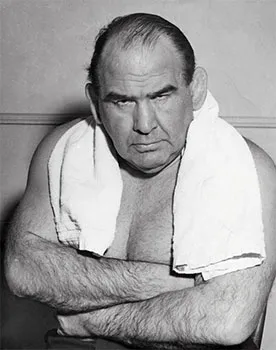 Not many did. He faced and defeated the very best fighters of his era, legends such as Stanislaus Zbysko, Orville Brown, Joe Stecher, Jim Londos, Dick Shikat, Fred Beel, Jack Leon and many other wrestling titans during his record-setting five World Championship reigns. By his own records, during a career that lasted more than four decades, Lewis wrestled in over 6,200 matches, many of them legitimate, and reportedly lost only 33. Following his retirement from the ring, Lewis (who suffered from a number of serious health issues, including trachoma, due to his time in wrestling) travelled the country as the manager of his protégé and successor, NWA World champion Lou Thesz.
Not many did. He faced and defeated the very best fighters of his era, legends such as Stanislaus Zbysko, Orville Brown, Joe Stecher, Jim Londos, Dick Shikat, Fred Beel, Jack Leon and many other wrestling titans during his record-setting five World Championship reigns. By his own records, during a career that lasted more than four decades, Lewis wrestled in over 6,200 matches, many of them legitimate, and reportedly lost only 33. Following his retirement from the ring, Lewis (who suffered from a number of serious health issues, including trachoma, due to his time in wrestling) travelled the country as the manager of his protégé and successor, NWA World champion Lou Thesz.
The Strangler is a member of the Wrestling Observer Newsletter Hall of Fame (1996), the George Tragos/Lou Thesz Professional Wrestling Hall of Fame (1999), the Professional Wrestling Hall of Fame and Museum (2002), the WWE Hall of Fame (2016), and the International Professional Wrestling Hall of Fame (2021).
Robert “Ed ‘Strangler’ Lewis” Friedrich died on August 8, 1966 at the age of 76.
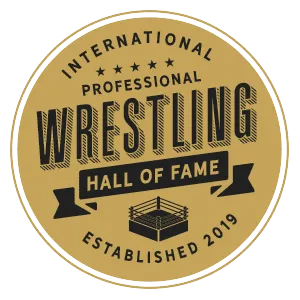 The International Professional Wrestling Hall of Fame (IPWHF) announced its first-ever induction ceremony. The event will take place at the Desmond Hotel on August 28, 2021 in Albany, NY.
The International Professional Wrestling Hall of Fame (IPWHF) announced its first-ever induction ceremony. The event will take place at the Desmond Hotel on August 28, 2021 in Albany, NY.
The inaugural induction ceremony will include 24 wrestlers:
Bruno Sammartino, Ric Flair, Hulk Hogan, Andre the Giant, Terry Funk, Giant Baba, Ed ‘Strangler’ Lewis, Mil Mascaras, Lou Thesz, Buddy Rogers, Frank Gotch, Danny Hodge, Great Gama, Yusuf Ismail, Paul Pons, Rikidozan, Martin ‘Farmer’ Burns, George Hackenschmidt, Evan ‘Strangler’ Lewis, William Muldoon, Satoru Sayama, Antonio Inoki, Stanislaus Zbysko, Tatsumi Fujinami
Information about the ceremony can be found at the IPWHF’s website.
DAN GABLE, 1972 OLYMPIC GOLD MEDALIST AND NCAA COACHING LEGEND, RECEIVES PRESIDENTIAL MEDAL OF FREEDOM
By Stephen Von Slagle
December 7, 2020 at 12:02 p.m. EST
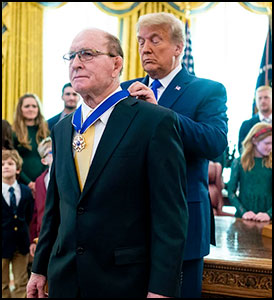
Dan Gable, who many consider to be, pound for pound, the single greatest wrestler that the United States has ever produced, was awarded the Presidential Medal of Freedom today in Washington D.C. by President Donald J. Trump.
The Presidential Medal of Freedom, which is the nation’s highest honor for a civilian, was established in 1963 by President John F. Kennedy and is awarded to individuals who have “made exceptional contributions to the security or national interests of America, to world peace, culture, or significant public or private endeavors.”
Gable, the only wrestler ever to receive this highest of honors, joins an elite group of athletes that includes previous awardees Babe Ruth (baseball), Jesse Owens (track & field), Muhammad Ali (boxing), Billie Jean King (tennis), Michael Jordan (basketball), and Tiger Woods (golf).
A three-time state high school champion and a two-time NCAA champion, Gable earned a record of 181-1 during his academic years, with his sole loss coming during the 1970 NCAA finals against Larry Owings. The loss to Owings would be the first and only defeat suffered by Gable during his long, storied career. After graduating from Iowa State University in 1970, Gable went on to compete internationally in freestyle wrestling, winning gold medals at the Pan American Games and the World Wrestling Championships in 1971. His dominance continued the following year when he won the Tblisi Tournament and capture
d a gold medal at the 1972 Olympics in Munich, Germany. In his 21 different Olympic qualifiers, Dan Gable scored 12 falls and outscored his nine other opponents by a margin of 130-1. Furthermore, en route to the gold medal, Gable did not have a single point scored against him during his six Olympic matches in Munich.
Dan Gable’s tenure as the head coach for the University of Iowa was equally, if not more, impressive than his career on the mat. The winningest coach in NCAA history, Gable led the Hawkeyes to 21 consecutive Big Ten championships as head coach and, under his leadership, Iowa earned 15 NCAA Division 1 titles, nine of which were consecutive (1978-86). Along the way, Gable coached no less than 45 national champions, 106 Big Ten champions, and 152 All-Americans. He also served as head coach for three separate Olympic teams (1980, 1984, 2000), was the assistant freestyle coach at the 1976 and 1988 Olympics, and coached 10 World Cup teams. During his nineteen years as Iowa’s head coach, Gable amassed a record of 355-21-5.
Regarding his Presidential Medal of Freedom award, Gable said, “I’ve received a lot of awards and have a lot of trophies, but this is the highest honor a civilian can receive. It’s really hard to wrap my head around that.”
